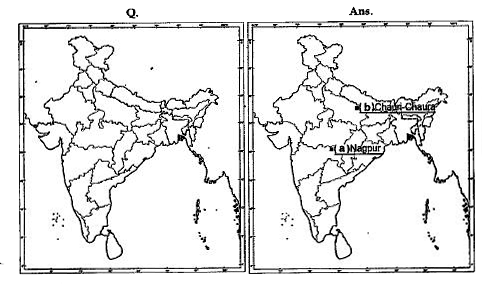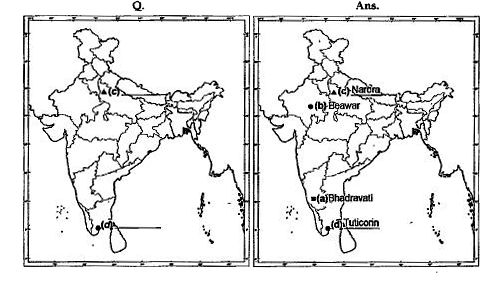Examine the different kinds of sources from which political career of Gandhiji and the history of the National Movement could be reconstructed.
(i) Gandhiji was known through his writings and speeches and that of his contemporaries. Gandhiji published in his journal .Harijan. letters that others wrote to him. Nehru edited and published .A Bunch of old letters. - collection of letters written to him during the national movement.
(ii) The vital source for reconstruction are government records. The British kept a close watch on Gandhiji.s activities. The letters and reports written by policemen and other officials are now accessible to the public.
(iii) The other sources are the contemporary newspapers published in English and vernacular languages. They tracked Gandhiji.s movement and reported on other relevant things.
(iv) The newspapers could be biased or prejudiced as people who published them were guided by their own political opinions and world views. These views shaped what was published and the way events were reported.
(v) The accounts published in a London newspaper would be different from a report in an Indian nationalist paper or the reports on the salt march in the Time magazine.
(vi) Mostly official accounts often expressed what the higher officials wanted to believe. Being aware of possibilities of a rebellion occurring, they still liked to pretend that nothing was amiss.
(vii) A study of the fortnightly reports on the Dandi March reveal the Home Department was unwilling to believe that Gandhi.s actions evoked an enthusiastic response from the masses.
(viii) The march was seen as drama or as a desperate effort to mobilise people who were unwilling to rise against them.
Topper's Solved these Questions
- MAHATMA GANDHI AND THE NATIONALIST MOVEMENT CIVIL DISOBEDIENCE AND BEYOND BOOK - FULL MARKSCHAPTER - MAHATMA GANDHI AND THE NATIONALIST MOVEMENT CIVIL DISOBEDIENCE AND BEYOND EXERCISE - ADDITIONAL QUESTIONS SOLVED (V. Project Work)
1 Videos
- KINSHIP, CASTE AND CLASS EARLY SOCIETIES BOOK - FULL MARKSCHAPTER - KINSHIP, CASTE AND CLASS EARLY SOCIETIES EXERCISE - PREVIOUS YEARS BOARD QUESTIONS SOLVED
29 Videos
- PEASANTS, ZAMINDARS AND THE STATE BOOK - FULL MARKSCHAPTER - PEASANTS, ZAMINDARS AND THE STATE EXERCISE - Previous years board questions solved
24 Videos
Similar Questions
Describe the different sources from which we can reconstruct the political career of Gandhiji and the history of the nationalist movement.
View SolutionHistorians have used different kinds of sources in reconstructing the political career of Gandhiji and the history of social and nationalist movements. Substantiate the statement with examples
View Solution
Knowledge Check
Among different kinds of water which of the following is free from bacteria ?
ADeep well waterBSea waterCWater of hot springsDRain water as it falls down
How have the diffetent kinds of available sources helped the historians in reconstructing the political career of Gandhiji and the history of the national movement that was associated with it ? Explain.
View SolutionExplain three different kinds of sources through which we come to know about Gandhiji. Give any two problems faced while interpreting them.
View SolutionDescribe the strengths and weaknesses of oral history. Mention any four sources from which the history of partition has been constructed.
View Solution(A) Locate and label the place on the given outline political map of India:
(a) The place where the Indian National Congress Session was held in December, 1920. 1
(b) The place where 22 policemen were burnt forcing Gandhiji to call off the Non cooperation Movement.

(B) The following features are to be located and labelled on the given India political outline map:
(a) Bhadrawati – Iron and Steel Plant
(b) Beawar-Mica Mine
Identify the features marked on the same given India political map and write their, names:
(c) Nuclear Power Plant
(d) Major Sea Port

(a) Name the place where the Indian National Congress session was held in December, 1920.
(b) Name the place where 22 policemen were burnt forcing Gandhiji to call off the Non-cooperation Movement.
(c) Name the nuclear plant located in Uttar Pradesh. (d) Name the iron and steel plant located in Chhattisgarh. (e) Which is the southernmost sea port of India?
View SolutionName any three natural fibres. What are the different sources from which natural fibres are obtained?
View SolutionA seminar was held in New York on the problems of finance. Its topic was ' The Different Finance Sources available at the Global Level in the Modersn Context . ' 200 representatives from different countries participated in this seminar. All the representatives expressed their respective opinions. One of the sources of finance discussed in the seminar was such through which the foreign companies could issue their securitiers in India. Looking at the great possibilities of obtaining capital from the investor in India, all of them showed a great interest in the discussion of the source. Another source of finance which created interest in every one was the source through which money could be obtained from the investors in America and other Wuropean countries. Since this sources was concerned with a very big area, the number of people who took interest in it was also larger. One of the Indian representatives threw light on the special characteristics of this source. His presentation was appreciated by one and all . In the final seesion of the seminar, the discussion took place on such a source of finance which could be used only in America . In the end of the seminar , the organisers thanked all the guests, and the seminar came to a successful conclusion.
In the above paragraph , three international sources of finance were discussed. Quoting the relevant lines identify those sources and explain them .
View SolutionExplain any four sources to reconstruct the history of Mauryas. Examine the system of Mauryan administration.
View Solution
